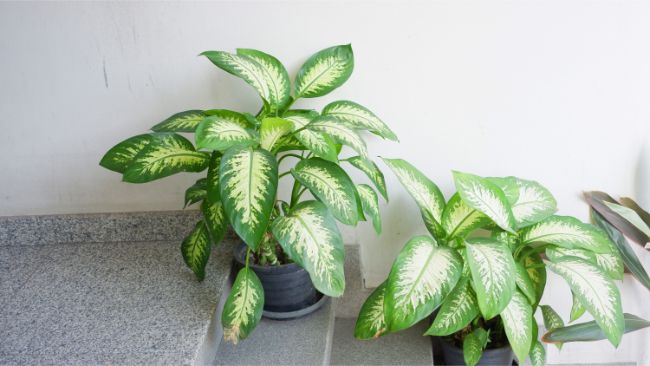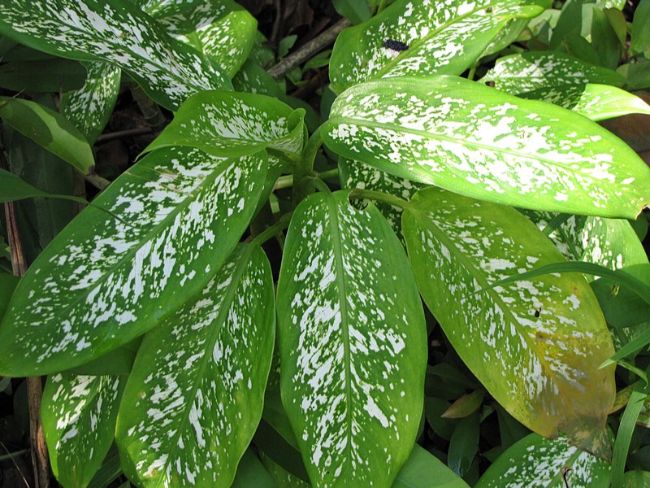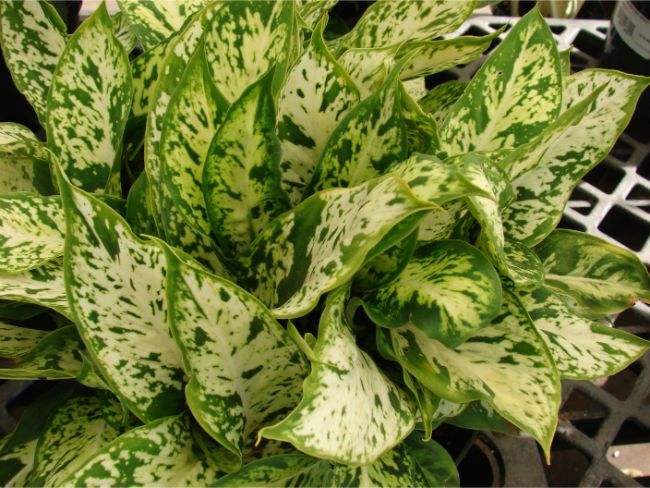The Dieffenbachia is a gorgeous houseplant, and one of the most popular for very good reasons. While fairly adaptable and easy to care for, dieffenbachia leaves turning yellow is a pretty common complaint.
Why Are Your Dieffenbachia Leaves Turning Yellow? Dieffenbachia (Dumb Cane) leaves most commonly turn yellow due to overwatering, but other causes include lighting problems, temperature extremes, low humidity, pests or nutrient deficiency.
Identifying the problem is easy if you take a few minutes to look at the growing conditions your plant is in. This article will help you assess your Dieffenbachia and show you what to do to fix any issues.
Why Are My Dieffenbachia Leaves Turning Yellow?
The Dieffenbachia is a marvelous plant with a lot of great qualities but it can also be a bit tough to figure out when something goes wrong. I’m here to shed light on one of the more frustrating problems with the Dieffenbachia, its leaves turning yellow.
Dieffenbachia can withstand quite a range of growing conditions, including temperatures from 50-80°F and a range of lighting, water and humidity.
Of course, every plant has its limits, and your Dieffenbachia will begin to lose its luster and develop yellow leaves if its needs are not met. Let’s look at each cause of Dieffenbachia leaves turning yellow in turn and work out how to fix your plant.
Overwatering
Overwatering is the most common cause of yellow leaves on your dieffenbachia, causing progressive, generalised yellowing of the foliage. This is an issue that is common to many houseplants, as many of us have a tendency to water too often.
Excessive watering causes the soil to remain waterlogged for extended periods of time, resulting in reduced air flow to the roots. Soggy soil literally drowns your plant, as the roots are a major source of oxygen uptake, essential for healthy functioning of your plant.
Without well functioning roots, normal plant processes are hampered, leading to progressive, generalized yellowing of the leaves. Left too long, the roots will succumb to opportunistic fungal and bacterial disease and the plant will be doomed.
You can spot overwatering easily by feeling the soil, or poking your finger down a few inches. You’ll notice the pot is heavy as it is full of water. If you think root rot may be setting in, you can ease the plant out of its pot and check the roots. Black/brown and mushy roots indicate root rot and there can often be an odor of rotting vegetation.
If you identify the problem at an early stage, simply stop watering and let the soil dry out fully, before resuming watering very cautiously.
If things are looking a little worse, read my guide to how to fix an overwatered plant.
Prevention
To avoid the yellowing of leaves, it’s best to water your Dieffenbachia by thoroughly soaking the soil to the point until it begins to come out of the holes in the bottom of the pot and into the drip pan. Once finished, let it absorb what it needs for a few minutes before emptying the excess water from the drip pan.
Don’t water again until the top few inches of soil are almost completely dry. It’s hard to say exactly how long this will take because it depends on so many things, including changes in temperature, light, and humidity.
The best way to determine when it’s time to water your Dieffenbachia again is to simply monitor your plant and test the soil by sticking your finger into it a couple of inches. When you feel little to no moisture, go ahead and give it some water. Typically, Dieffenbachia needs more water during the spring and summer and considerably less during the fall and winter.
Underwatering
At the other end of the spectrum, we have underwatering. With the best will in the world, sometimes we just forget to water a plant for a little too long. This will often lead to yellow or brown leaves, typically of new growth and older, lower leaves too, but not generally in a generalized pattern, as with overwatering.
This should be an easy cause to identify as Dieffenbachia plants are reasonably drought tolerant. By the time the leaves turn yellow/brown and a little crispy, the soil will be completely dry. The pot will feel much lighter than normal and the plant leaves will look very dry indeed.
Thankfully, dieffenbachia plants are fairly resilient, so if you resume a normal watering schedule, the plant should recover. I would advised watering attentively for approximately one month before pruning off any yellow or brown foliage to avoid stressing the plant excessively.

Low Humidity
Although more tolerant to low humidity than some indoor plants, your dieffenbachia can still develop yellow leaves in very low humidity conditions.
This is most likely to happen when the plant is moved from a higher humidity location to a lower humidity location and the plant has to make a rapid adjustment to the new growing conditions.
This issue is particularly common if you buy a dieffenbachia plant that has been grown in perfect, high humidity conditions at the nursery and you then bring it home to the more arid conditions that many of us have in our homes.
When a plant is grown in high-humidity and then moved to a person’s home or office where there is less humidity, the change can affect the plant and make its leaves turn yellow. This change is usually short-lived and goes away after the plant has properly adapted to its new environment.
Read how to increase humidity for your houseplants easily and with minimal effort.
Temperature Extremes
Dieffenbachia plants do best in temperatures of between 50-80°F, and will begin to show signs of stress outside this temperature range. Yellow leaves are one of the most common signs of this stress reaction, as the plant is unable to function with the same efficiency outside these temperatures.
Most indoor spaces should be well within this temperture range, so this has most relevance for plants that are grown in hot rooms in summer, or kept next to a drafty window in winter. Temperature stress can also occur if you put your Dieffenbachia outside in summer and leave it out a little too long as the colder autumn night arrive.
If you think temperature stress may be playing a role, I recommend putting a digital thermometer next to your plant for a few days. These usually record the current temperature as well as the maximum and minimum temperature recorded, making it easy to detect whether conditions are suitable.
Lighting
Indirect bright light is best for the Dieffenbachia. Long periods of direct sunlight can be dangerous to a Dieffenbachia as they are susceptible to burning and drying out. The right amount of light is crucial in these plants, not only because it directly impacts the health of the plant but also because too much or too little light complicates how much and how often you need to water the plant as well.
To avoid these issues, find a spot where the plant is not in the path of direct sunlight for more than 1-2 hours per day, and ideally is kept out of direct sunlight, but given bright, indirect sunlight throughout the day.
Keep in mind that the layout and the windows in the room directly affect the amount of sunlight that gets in. This will vary depending on the direction your windows are facing as well as how the room is arranged.
Bear in mind that the changing seasons also change the amount of light and heat available to your plant. You may need to move your plant to different locations in your home throughout the year to avoid extremes of excessive or insufficient light.
Some yellowing of the leaves is common during the changing seasons, particularly in autumn and winter, when old foliage is more likely to die back as part of the natural growth habit of this plant.
Drafts
If you’re pretty sure you’ve got most other aspects of care dialed in, but your plant still seems to be getting a lot of yellow leaves, have a think about drafts. Air conditioning units, heating vents or leaky windows are common culprits.
Although more tolerant than some indoor plants, your dieffenbachia can show considerable signs of stress, so move your plant to an alternate location to fix this problem.
Pests And Disease

Dieffenbachia leaves turning yellow can also be due to insect infestations and infections from fungi or bacteria. Dieffenbachia can be affected by most of the common houseplant bugs, including mealy bugs, scale and spider mites.
Checking your plant regularly for bugs, by inspecting both sides of the leaves can go a long way to preventing or dealing with a problem at an early stage. Sap-sucking buys will cause marked leaf yellowing as they harvest the precious juices within your plant.
Spider mites can be particularly dangerous, as they are so small it can be hard to detect a problem before it’s almost too late. Look for fine webs on and between the leaves and don’t delay treating if you detect a problem.
Try treating your plant with some of these natural options for dealing with houseplants bugs.
Fungal and bacterial diseases can also turn your leaves yellow. Overwatering is by far the most common reason why a dieffenbachia plant will develop disease problems, so err on the side of caution and you can prevent most of these from causing a problem.
Nutrient Deficiency
A range of nutrient deficiency problems can result in your Dieffenbachia leaves turning yellow, most commonly nitrogen and phosphorus deficiency.
A plant that has not been repotted for years and left without fertilizer will eventually display signs of nutrient deficiency and yellowing leaves. Nutrient deficient soil is commonly used for growing a range of houseplants, with a mix of peat moss and perlite being one of my favorite mixes for plants including dumb canes.
The drawback of this is that you really must provide supplemental fertilizer to help your dieffenbachia grow and thrive to its fullest potential. Just be careful not to overdo it though, as nutrient toxicity can arguably cause more problems.
Fertilize your Dieffenbachia every 2-3 weeks during the growing season with a balanced, water soluble fertilizer, made up at half strength. Alternatively, you could use an organic fertilizer, but there are pros and cons of this. Read my article about fertilizing indoor plants for more information.
Can I Remove Yellow Leaves On My Dieffenbachia?
This depends on the cause. For pest and disease problems, it’s best to prune off affected foliage immediately as this may the only way to save the plant. For other causes, nursing the plant back to health first, before pruning yellow foliage will cause the plant less stress.
Last Word
Hopefully, this article will help you fix why your dieffenbachia leaves are turning yellow and prevent any problems in the future. The main take-away is to consider each cause in turn, assess your plant carefully and make changes to improve the healthy of your plant.

